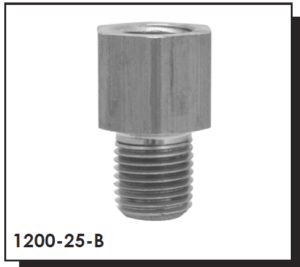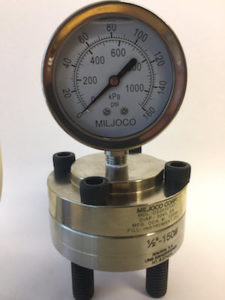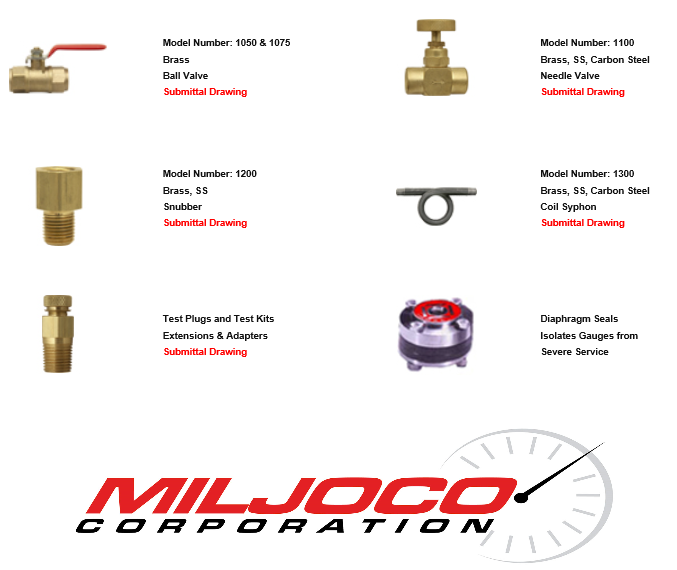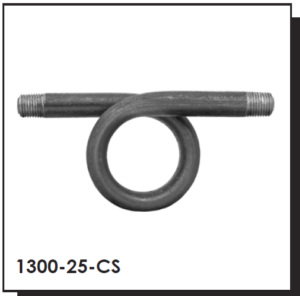Sometimes when we add fries and other sides to a food order, the price of lunch and the calorie count can double. Let’s make sure we can enjoy what we order! In the last blog I outlined some suggestions for pressure gauges in hydronic HVAC and plumbing systems. Today, I offer some thoughts on pressure gauge accessories in the R L Deppmann Monday Morning Minutes.
If you like what you read, we will have a specification after this blog series.
Pressure Gauge Pigtails
Let’s start with THE MOST IMPORTANT accessory for pressure gauges in steam systems. Past R.L. Deppmann Monday Morning Minutes series looked at steam systems. We know that steam is hot, we know steam condenses, and we know if we try to pass steam through condensate, it will flash and cause hammer. If steam gets in the bourdon tube of a gauge, the condensate will sit in the lower part of the tube and will be unable to drain. The next time it sees steam, the gauge is destroyed and will require replacement!
A pigtail protects the gauge by forming a condensate trap. They come in steel, stainless steel, and brass. I recommend steel for applications up to 150 PSIG. It handles the temperature, pressure, and is the least expensive pigtail loop.
Pressure Gauge Isolation Valves
What can be more mundane than a shut-off valve? Well, let’s add a thought. Most gauges are installed with isolation quarter turn ball valves. It can be quite common for pressure gauges to not work well and most are highly inaccurate after just a couple of seasons. Bet you didn’t know that the shutoff valve has much to do with the continued accuracy of a gauge.
When a pressure gauge is installed and the shutoff valve is closed, the gauge is reading the last pressure it experienced. When the ball valve is opened quickly, a new pressure rushes into the gauge quickly. The bourdon tube reacts to change the pressure quickly and overshoots a bit before resting at the pressure. Every time the gauges overshoots, the gauge accuracy is distorted.
No mechanical technician or maintenance person opens a ball valve slowly. OK, that is an exaggeration. Maybe 10% open the ball valve slowly. The other 90% destroy the accuracy on a regular basis starting from the day the system is started up. Most sane people HATE needle valves. They take a long time and many turns to open. That slow opening valve will save the pressure gauge. Use a needle valve instead of a ball valve and just accept the extra 15 seconds it takes to open the valve.
Pressure Gauge Snubbers
 Pressure gauge snubbers retard or dampen pulsations at the gauge. We have all experienced the gauge in a closed system with a bouncing needle due to air in the system or a pump vibrating. Well, if you have air or pump vibration in a closed system, you have more trouble than a simple pressure gauge needle moving. Other equipment will be damaged. If the fill pressure is too low, set the PRV to the right cold fill pressure. If your air separator or air/dirt separator is not removing the air, start specifying Bell & Gossett quality air separators. If your pump is vibrating, give us a call and we’ll help you with recommendations. Pressure snubbers are not expensive, but there should be no pulsations in closed hydronic systems.
Pressure gauge snubbers retard or dampen pulsations at the gauge. We have all experienced the gauge in a closed system with a bouncing needle due to air in the system or a pump vibrating. Well, if you have air or pump vibration in a closed system, you have more trouble than a simple pressure gauge needle moving. Other equipment will be damaged. If the fill pressure is too low, set the PRV to the right cold fill pressure. If your air separator or air/dirt separator is not removing the air, start specifying Bell & Gossett quality air separators. If your pump is vibrating, give us a call and we’ll help you with recommendations. Pressure snubbers are not expensive, but there should be no pulsations in closed hydronic systems.
I do like pulsation dampeners or snubbers on condenser water systems with open towers. There is an application where we introduce air constantly. I also like them on steam systems. I don’t expect large pulsations in steam systems but you can have the occasional hammer when steam flows through condensate. Even the best designs will have a trap fail at some time. Why break the pressure gauge if it is nearby.
Finally, I like them on plumbing systems where pumps and other equipment turning on and off will cause some pressure changes. In a hydronic system we don’t normally cycle pumps on and off very often. In plumbing systems, there is more of a chance. Make sure the snubber conforms to the US Safe Drinking Water Act.
Pressure Gauge Liquid Fill
Many specifications have glycerin or silicone liquid filled options for pressure gauges. HVAC and plumbing are pretty steady systems compared to some process applications. I don’t care for liquid filled gauges in HVAC and plumbing systems. These have a temperature limit which is usually 140°F. They also have a minimum temperature of 0°F. So we don’t want them on hot water heating systems, steam systems, or mounted outside. In addition, they do leak at times.
The benefit to liquid fill is to soften the friction of the mechanical parts of a pressure gauge when it is moving frequently, such as with pulsations. Not a big issue in our systems. Save your money.
Pressure Gauge Diaphragm Seals
 Diaphragm seals protect the gauge from the process fluid. They can be cleaned out and sludge and can removed. A big deal when pumping acid but not much use in a hydronic system. The only possible use would be on sewage pumps but let’s not go there if you know what I mean.
Diaphragm seals protect the gauge from the process fluid. They can be cleaned out and sludge and can removed. A big deal when pumping acid but not much use in a hydronic system. The only possible use would be on sewage pumps but let’s not go there if you know what I mean.
After I complete the thermometers blogs, there will be a complete specification available for your review. It is not proprietary but should keep you out of hot water—–hot steam, chilled water or other dilemmas.
Next week the R L Deppmann Monday Morning Minutes will continue to amaze you when we tackle thermometers.



